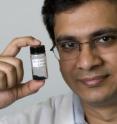Northern Illinois University scientists find simple way to produce graphene
Scientists at Northern Illinois University say they have discovered a simple method for producing high yields of graphene, a highly touted carbon nanostructure that some believe could replace silicon as the technological fabric of the future. The focus of intense scientific research in recent years, graphene is a two-dimensional material, comprised of a single layer of carbon atoms arranged in a hexagonal lattice. It is the strongest material ever measured and has other remarkable qualities, including high electron mobility, a property that elevates its potential for use in high-speed nano-scale devices of the future.
In a June communication to the Journal of Materials Chemistry, the NIU researchers report on a new method that converts carbon dioxide directly into few-layer graphene (less than 10 atoms in thickness) by burning pure magnesium metal in dry ice.
"It is scientifically proven that burning magnesium metal in carbon dioxide produces carbon, but the formation of this carbon with few-layer graphene as the major product has neither been identified nor proven as such until our current report," said Narayan Hosmane, a professor of chemistry and biochemistry who leads the NIU research group.
"The synthetic process can be used to potentially produce few-layer graphene in large quantities," he said. "Up until now, graphene has been synthesized by various methods utilizing hazardous chemicals and tedious techniques. This new method is simple, green and cost-effective."
Hosmane said his research group initially set out to produce single-wall carbon nanotubes. "Instead, we isolated few-layer graphene," he said. "It surprised us all."
"It's a very simple technique that's been done by scientists before," added Amartya Chakrabarti, first author of the communication to the Journal of Materials Chemistry and an NIU post-doctoral research associate in chemistry and biochemistry. "But nobody actually closely examined the structure of the carbon that had been produced."
Source: Northern Illinois University
Other sources
- Scientists find simple way to produce graphenefrom Science Daily13 years ago
- Scientists find simple way to produce graphenefrom Physorg13 years ago


